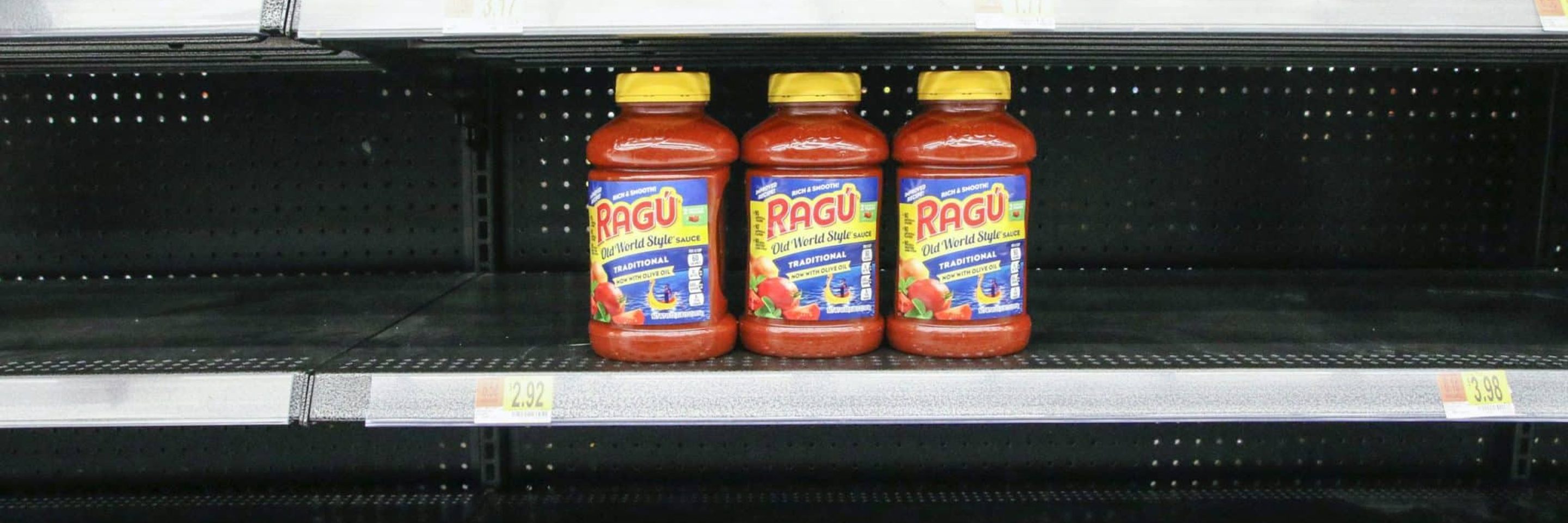
Food inflation and grocery shortages are widespread but the problem is deeper than just ingredient shortages and supply bottlenecks.
Inflation has usurped infection as the biggest negative impact on the global economy.
The supermarket shelves are stocked once again but perhaps not as densely as they were prior to the pandemic, and what is lining the aisles is increasingly expensive.
At the heart of the consumer cost-of-living pressures around the world is the price of putting food on the table, which, alongside energy, is rising at an alarming rate.
In advanced economies such as Germany, the annual food inflation rate is at 14% according to the OECD, while the United States and United Kingdom are hovering around the 13% mark.
Food inflation jumped to 5.6% in June, up from 4.3% in May, driven by fresh food prices up 6.2% on June last year – the highest inflation rate since May 2009.
It is often presumed that the production and manufacturing end of the supply chain, such as raw ingredient shortages and transport bottlenecks, were key factors whenever supermarket shelves were down on stock.
While that can be true, the machinations at the other end of the equation – the retailers – were exposed in June when a battle between UK supermarket chain Tesco and product suppliers entered the public realm.
Manufacturers such as global giants Heinz and Mars Pet Foods proposed to hike wholesale prices, reportedly by as much as 30%, in response to the rising cost of manufacturing.
Tesco pushed back and refused to stock the labels at proposed higher prices, which led to Heinz and Mars, the owner of pet food brands including Whiskas, Dreamies and Pedigree, halting their supplies.
The supermarket framed the issues as a responsibility to customers, arguing that the proposed hikes in product prices were ‘unjustified,’ while the manufacturers defended the higher prices, pointing to rising costs of energy, ingredients, transport and labour.
Heinz and Tesco have since resolved their differences, but Mars pet products remain absent. Meanwhile, the prices of Mars products at other outlets have increased by as much as 35%.
What do food inflation pressures mean for retailers, producers and manufacturers?
The retail dilemma – who will buy it?
Mark Lumsdon-Taylor is Partner and joint head of the agrifood and farming practice at Baker Tilly network firm MHA UK.
He says pressure is piling on supermarket chains from their suppliers and it’s a major reason why products are not reaching the shelves.
“The increased cost of staples like tomato ketchup, baked beans are going up,” he says.
“It is a question of whether the retailers are prepared to supply it to fill their shelf space when the consumers might not pay for it.”
“Heinz tomato soup, is a world staple. It was around £2.50 for a pack of four, so 60p to 65p a can, but it is now £3.50 and heading nearer to £4, that’s a pound per can.
“It’s not as simple as products being unable to make it to the shelves. It’s certainly not that there isn’t a global supply of tomato soup. It’s still there.
“It is a question of whether the retailers are prepared to supply it to fill their shelf space when the consumers might not pay for it.”
Tesco, which commands about 27% of the UK’s grocery market share, is facing its own battles with consumers as data showed its customers were buying fewer grocery items and switching to cheaper own-brand alternatives.
“Large-scale supermarkets are getting pressure from their supply chains, who are saying, ‘we need to charge you more for this,’” Mr Lumsdon-Taylor says.
“But that cuts into the retailers’ margins and the supermarket are starting to say, ‘we’re not accepting those price increases, we will not stock it at those prices.’”
The production crisis – the three F’s
The war in Ukraine has been cited as a key factor in rising food prices around the world, as the conflict cuts grain supplies and forces prices higher.
Ukraine accounts for 10% of the world wheat market, and prior to the February invasion, the eastern European nation shipped about 5 million tons of grains a month. It commands more than 50% of world sunflower oil trade, as well as 15% of the corn market and 13% of the barley market.
“Grain is a good example of an input into numerous commodities, including bread, so the war is one factor in the higher production costs,” Mr Lumsdon-Taylor said.
“But it’s far from the only one.
"How do we make food? For a farmer, it’s fuel, fertiliser and feed.
"Fertiliser prices over the course of the last six months to a year have more than doubled in some cases. And we all know about fuel costs.”
Low yields and high costs leave producers passing higher prices onto the next business that makes the product for the supermarket, which they then pass on to the consumer.
Manufacturers squeezed on both sides
Forrest Farms is one of the largest fruit-fillings manufacturers in the UK and a Baker Tilly client, and it has felt the pressure from both sides of the equation.
In 2020, the UK produced nearly 18,000 tonnes of Bramley apples, but last year it fell to just 12,000 tonnes and put a rocket under produce-pricing and related lines of goods.
“Take mincemeat, fruit mince for pies, Christmas cake, that require inputs such as vine fruits, purees and cherries,” he says.
“There was a global shortage of key ingredients, strawberries and Bramley apples, thanks to a low yield. What did that do? It exacerbated pricing in particular lines of ingredients.
"The price of Bramley apples was sitting around £300 a ton but it’s now £530 a ton.
"Manufacturers are consolidating their lines more and more because it's not cost effective to run all those different lines with all those different inputs."
"The input of apples becomes a filling that then goes into, let's say, an apple pie or a cream cake and this is where the upstream and downstream pressures meet.”
When supermarkets are not prepared to accept the prices, there is a negotiation and a look at their margins.
“If the retailer doesn't like the price hike, then the lines get dropped,” Mr Lumsdon-Taylor says.
“Two years ago, you may have had 10 varieties of a particular type of raspberry jam, whereas now you might have three.
"Manufacturers are consolidating their lines more and more because it's not cost-effective to run all those different lines with all those different inputs.
"Asda, another supermarket chain in the UK, has reduced the number of lines it sells by about 12%.
"Several lines were delisted this year by two large retailers because they just felt that they were too similar to their existing lines; it was going to be too expensive to do keep them.
"The whole piece around the choice of food and empty shelves is not as simple as, ‘there isn't enough supply’, it's much more complicated than that.”
What’s next for food retail?
Mr Lumsdon-Taylor says in the immediate term there is unlikely to be any change to this approach of consolidating production lines as supermarkets are making money.
But the looming high fat sugar and salt (HFSS) legislation set to be introduced next year will force changes in production and consumer behaviour.
A ban on multi-buy offers for HFSS foods, such as buy-one-get-one-free offers, comes into force in October 2023, followed in January 2024 by a ban on advertising junk food before 9pm on television, as well as online.
A significant level of investment will be necessary from supermarkets if the legislation has the desired effect on consumer behaviour.
“Politically, we don’t talk enough about the importance of food, the importance of agriculture and farming,” he says.
“The Department of Environment, Food and Rural Affairs, which includes agriculture and farming, sits at the bottom of the cabinet table in the UK.
"It's not a priority department for the country and it hasn’t been for years and years.
"We're not consistent about whether we are a food-producing nation or not, and until that changes, we’re going to have this constant cycle of challenge.
"What's the solution? I think the HFSS is a way of doing this, it will start to change and educate consumers in terms of their buying habits.
"If consumers are not prepared to spend, or are reluctant to spend, and take those nice-to-have goods like cake, supermarkets will think twice about it, and reduce or remove lines.
"It’s a complex area, but it will be an encouragement for businesses to look at their lines and properly review their product ranges.”









